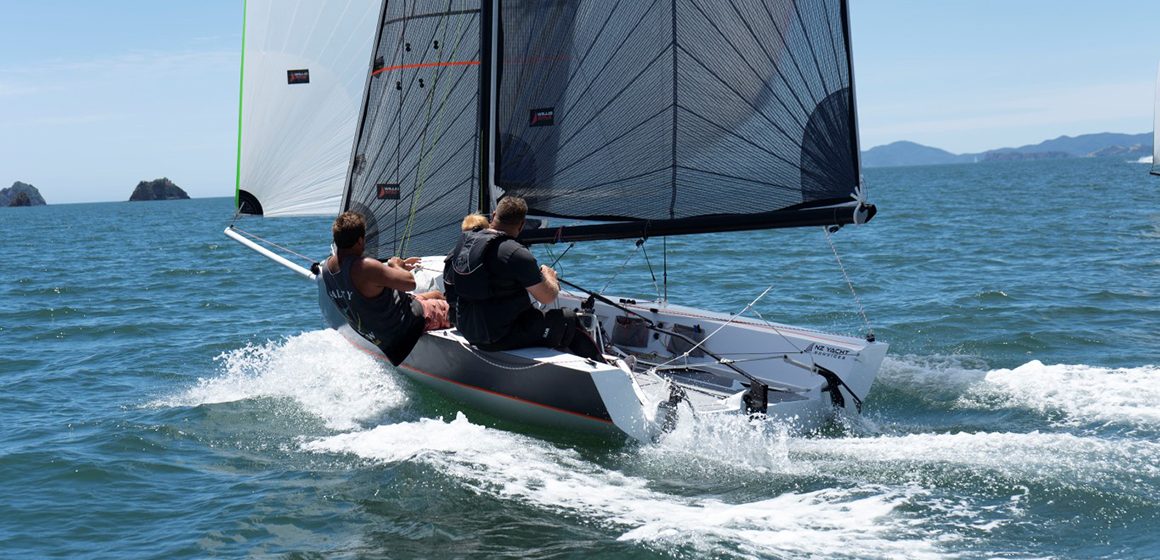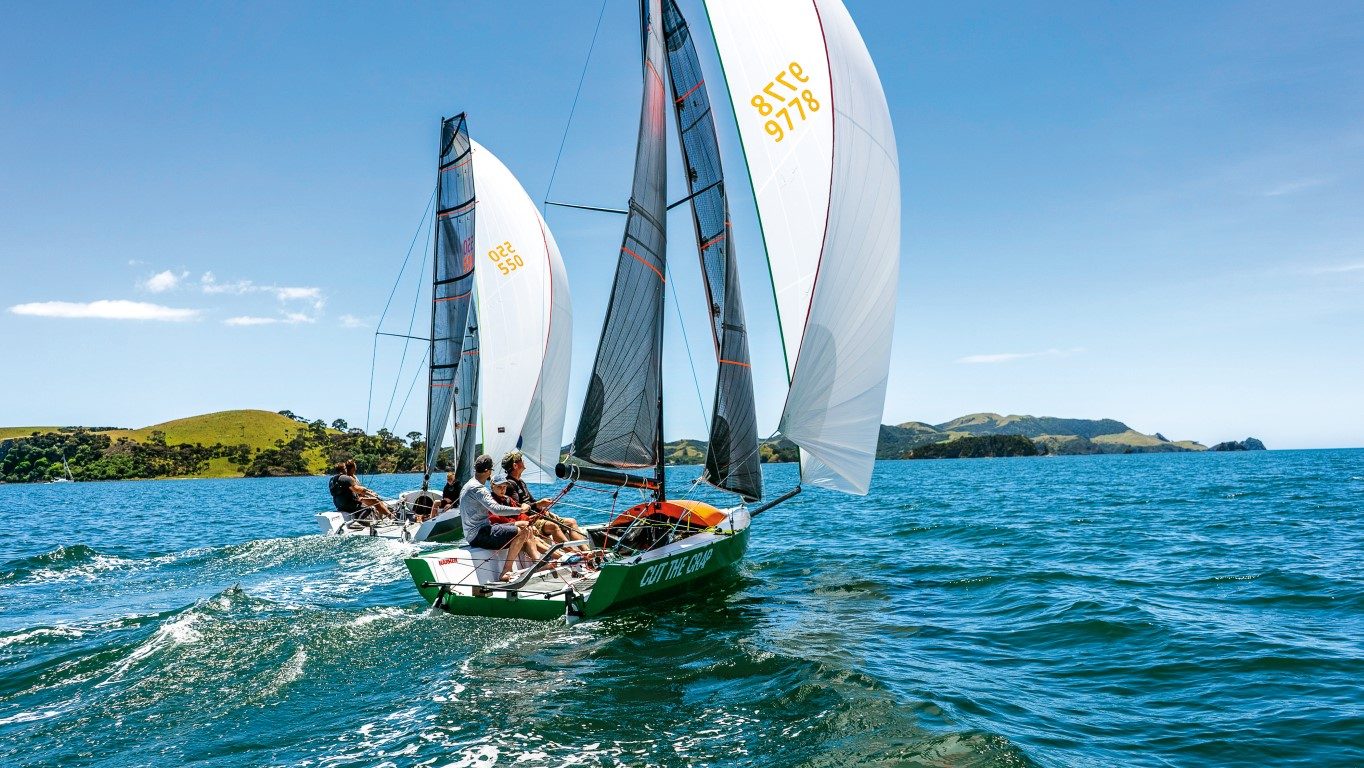‘Behemoth’ is a word which springs to mind or, perhaps more nautically, ‘leviathan’.
- Light and easy to launch
- Cleverly arranged running rigging
- Performance - a pure shot of adrenalin
- Only 5.5m long
- Competitive and fun

Last year’s Level 4 lockdown was a difficult time for all Kiwis, but it also gave Bay of Islands rigger Paul Smith the chance to get The Racoon – his Shaw 550 – into the water.
Backyard boatbuilding projects are notorious for taking a long time. For Smith, the enforced break from his usual work schedule was a blessing in disguise – it meant he could get on with finishing off a personal project which he hopes will see him spending more time on the water with his family.

Smith, universally known as Buddha, obtained the incomplete hull and decks of the 550 three years ago, when Unitec’s boatbuilding programme, which had been building the boats, was closed down. His family had previously owned a Thompson 750 and a SR26, but he’d been boatless for a while.
He’d done the rigging on the first Shaw 550 to be launched, the brightly painted and catchily-named Cut the Crap, currently owned by Kerikeri sailor Tony Dalbeth-Hudson, and is friends with designer Rob Shaw, so he knew about these small, fast, trailerable boats. “I had been looking for a little boat for me, so when this came up I decided to buy it.”
Shaw originally designed the 550 as a versatile club racer. Rather than being one of his high-performance sports boats – which often sprout racks, trapezes and, more recently, foils – this 5.5m vessel has a broader, flatter hull shape with a lot more form stability. It has a small cabin, simplified rig, lifting centreboard and twin rudders, and is designed for day sailing or club racing, although Shaw reckons it’d go pretty well in longer-course shorthanded racing, too.

“The hull shape’s designed for stability and power, and to be sailed with a crew of one, two or three,” Shaw says. “It has a higher ballast ratio and more powerful hull than a sports boat, so I think it will appeal to people who want similar performance to a sports boat but appreciate the simplicity and more forgiving nature of this style of boat.”
The twin rudders are something a bit different – Shaw says they work well with a powerful hull like that of the 550. “These boats need to be sailed with a bit of heel angle to reduce the wetted surface area and gain the stability benefit of the more powerful hull and increased ballast, unlike the finer hulls typical of sports boats, which are designed to be sailed more upright.”

The tiller’s attached to a bar which runs across the back of the boat to operate both rudders synchronously, and the boat is steered as normal. Smith says it’s taken a bit of tweaking to get the rudder angles just right but the system works really well, providing a light helm and good control even when the boat is heeled.
Part of Shaw’s original vision for the class was that it could be sailed by a parent and one or two children, and on the day of our test sail in the Bay of Islands, Shaw sailed with his 10-year-old son Florian and another adult (aboard Cut the Crap in these photos), while Smith had Bailey (also 10) along for the ride. Both kids finished the photo shoot with big smiles and more enthusiasm for sailing than usually gets shown after a session in an Optimist.

“The whole idea of this boat was to include Bailey in it, and my daughter Emma (7) as she grows up – something we can go sailing together as a family, but still be competitive,” Smith says.
The incomplete cedar, foam and fibreglass hull and decks, with carbon reinforcing in high-load areas, was trucked up to Smith’s home near Kawakawa in late 2017, and there it sat, waiting for attention, while he was busy running his business, NZ Yacht Services. Then came the first Covid lockdown, and Smith found himself with some time on his hands.
“It became a real lockdown project,” he says. “I’d been so busy in the business and sailing on an Etchell, I really hadn’t had time for my own boat. I had to beg, borrow and steal the materials from my mates, and at one point I went down the river in the dinghy to fetch some glue so I didn’t have to be on the roads.”
Smith completed the deck and faired the hull, then built details such as the foot chocks and rudder gudgeons and planned the deck layout, before handing it over to be painted. A charcoal carbon-weave-look vinyl wrap with a bright orange stripe was applied over the white gloss paint (coincidentally, giving it the same colour scheme as Shaw’s original 9m canter, Karma Police).
Smith decided to set the boat up slightly differently to Cut the Crap, adding an internal mainsheet system, which places the purchases and blocks inside the boom, emerging at a central pedestal. Other controls such as the prod and tack lines also run under the deck and emerge through holes in the cockpit sides, so there isn’t a mass of ropes everywhere.
“I was trying to get as much string out of the cockpit as possible,” says Smith. “With the main especially, it means it’s all tucked away and tidy, and there’s just one piece of rope coming out of the boom.”
The next job – right up Smith’s alley – was fitting out and finishing the carbon mast section and boom and kitting out the boat with fibre rigging. The boat’s sail wardrobe has been designed and built by local sailmaker Craig Gurnell of Willis Sails in Kerikeri, and includes a main, two headsails, a masthead gennaker and a furling fractional code zero. Once again, tidy is the word – “we just furl it up then drop it to the deck and down the hatch,” Smith says.

Cut the Crap also has Willis sails, but no code zero (yet), giving Smith’s 550 a slight advantage on harbour course racing, though they are evenly matched on other points of sail.
As on many of Shaw’s smaller sportsboat designs, such as the 650, the gennaker is launched and retrieved out of the cockpit, but on this boat it can be stowed down below in the small cabin area, along with the outboard, anchor and other safety gear. When not sailing, the boat’s powered by a 2hp Yamaha outboard, which Smith has cleverly mounted on a fitting like an additional rudder gudgeon, attached to the rudder bar, so it can be steered with the tiller.
He says a trailer boat has made his life a lot easier. “The biggest issue with having a keelboat up here is keeping the bottom clean and keeping the barnacles off it. Every time I went yachting, it took me just as long to clean the bottom of the boat as it does to set this up. Also, I can take this boat home and store it in the workshop if I need to.”
The Racoon went into the water in October last year, and Smith says it has been “awesome” since the outset. “It was really windy that day. Rob [Shaw] had said if it was blowing over 20 knots to just leave it on the trailer, but since we’ve been sailing the boat we’ve found it really comes alive at 20 knots. We’ve had some absolutely epic rides on it, including one race when we had the best reaching leg I’ve ever had – big swells and an amazing gennaker ride. The boat two-sail reaches really well too.”

The regular schedule is Wednesday night racing, rum racing and some longer harbour racing out of the Opua Cruising Club, in a mixed fleet of keelboats and trailer yachts, and Bay of Islands Sailing Week. Racoon made her major racing debut at the January 2021 event, sailing in the E division on windward-leeward and harbour courses. After a slow start, Smith roared up the rankings to finish fourth overall on line, behind two larger Shaw designs and a Platu.
So far, the top speed recorded has been close to 20 knots — not bad for a 5.5m boat. Smith’s eyes light up at the thought. “The best ride we’ve had, we were absolutely flying, surfing along the swell like we were on a big Malibu surfboard. “Bailey’s been out a few times and he loves the speed — it’s all about passing boats for him.”
Sounds like a case of like father, like son.
Disclaimer: Writer Sarah Ell is married to Rob Shaw, and Florian Shaw is her son./>
‘Behemoth’ is a word which springs to mind or, perhaps more nautically, ‘leviathan’.
White Pointer has earned the respect of discerning customers in New Zealand and Australia, attracting a loyal and ever growing following for its high-quality, rugged and totally dependable aluminium trailer boats.
The hardtop SP635 shares the same underpinnings as the popular SF 635 which was a completely new model back in 2020.
The pride and joy of a multi-generational family, Bliss resides on a pier that’s home to a couple of other Elite motor launches – Sandspit Marina is a hot-spot for the Bill Upfold-designed vessels, with several calling this small marina home.